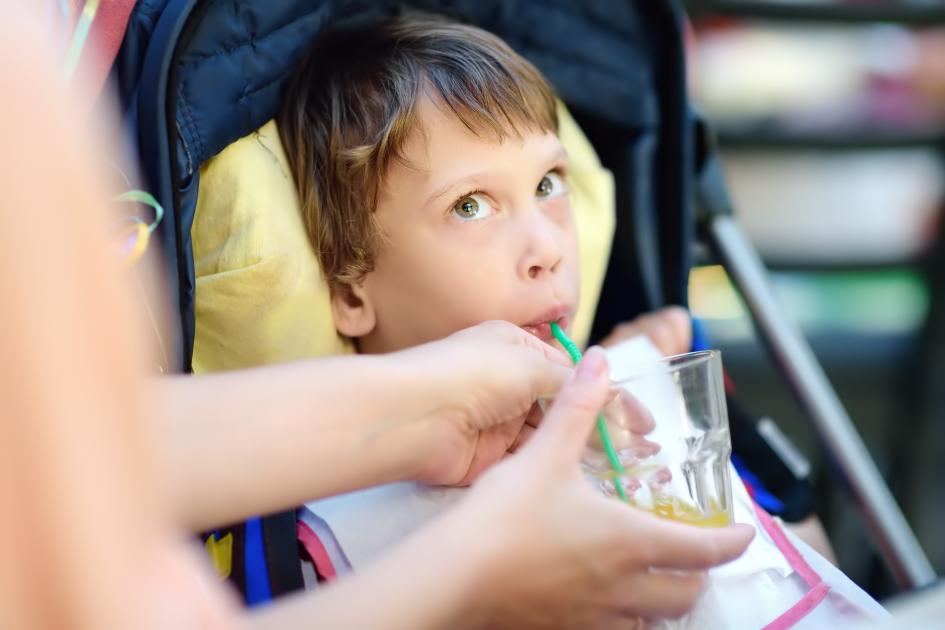DYSPHAGIA. SWALLOWING DIFFICULTIES
Dysphagia is an alteration of the swallowing of food, both solids and liquids, which includes medication and saliva. The origin of dysphagia is usually neurological, although it can also be mechanical, or because of being a tracheotomy tube carrier.

Dysphagia can have serious consequences. For this reason, it is important to be aware of the signs that alert us about the possibility of suffering from dysphagia. We can differentiate two phases of swallowing where alterations can occur:
The oral phase. If the oral phase is affected, there will be an effect on the efficiency of the swallowing, such as difficulties in controlling the food in the mouth.
The pharyngeal phase. If the pharyngeal phase is affected, we will find difficulties in the passage of food into the esophagus and stomach.
Warning signs and diagnosis of the dysphagia
- Cough
- Wet voice
- Regurgitation through the nose
- Recurrent respiratory infections
- Weight loss

In the event of warning signs of dysphagia, it is important that you visit your doctor of reference. The doctor will assess which tests to perform and to which professional to refer.
Risks of dysphagia
- If food enters the respiratory tracts (aspiration), respiratory complications and, in the worst case, asphyxia, can occur.
- Silent aspiration: Naturally, when food or liquids enter the respiratory tracts, these are expelled through the cough reflex. Some people with dysphagia preserve this reflex, but others have lost it and can suck in food or saliva without coughing, so aspiration can go unnoticed.
- Malnutrition and dehydration. Clearly, one of the consequences of not being able to eat and be sufficiently hydrated is malnutrition and dehydration.
Treatment of dysphagia
The objective of the treatment of the dysphagia is to achieve a safe and effective swallowing, orally whenever possible. Most people with dysphagia improve their swallowing and get to eat with some restrictions and/or adaptations.
In some people with severe dysphagia, improvement may be slow. Usually, at the beginning of the treatment, a nasogastric tube is placed as a feeding route and, depending on the evolution, it is removed or replaced by a gastrostomy tube (PEG). Generally, feeding by mouth happened gradually, starting by a small amount of yogurt.
The speech therapist is the professional who teaches swallowing maneuvers and exercises to improve swallowing. He or she also provides guidelines and recommendations for safe eating. One of the most recurrent treatments for dysphagia is the therapeutic program of neuromuscular electrical stimulation (NMES). This program is aimed at patients affected by neurogenic dysphagia, diagnosed with the performance video-fluoroscopy and who have any of these abnormalities:
- Alteration in tongue base retraction.
- Dysfunction of the elevation of the soft palate.
- Decrease in laryngeal ascent.
- Alteration in pharyngeal contraction.
- Dysfunction in the opening of the upper esophageal sphincter.
Neuromuscular electrical stimulation techniques used to treat dysphagia are applied to the floor of the mouth or pharynx. They allow to improve some muscular groups involved in the swallowing process, increasing the rise of the larynx, and favoring the glottic closure, or increasing the sensory input to the central nervous system facilitating the response to swallowing. The treatment combines neuromuscular electrical stimulation with therapeutic dysphagia exercises with speech therapy.
Restrictions and adaptations to eat and drink safely
To avoid the complications mentioned above, certain adaptations are made such as restriction of risk foods (rice, peas, lentils...) or changes in texture with the use of thickeners. It is also usually recommended to use a dessert spoon to have better control over the amount ingested. The duration of these adaptations can be temporary or permanent, depending on the evolution of the dysphagia. The physician and/or the speech therapist will be the professionals who will indicate which adaptations should be followed according to the individual needs of each patient.

Recommendations to eat safely
- Be awake, reactive, and cooperative.
- Avoid noise and distractions (TV, radio, visitors...).
- Do not talk or laugh while eating, talk only after swallowing.
- Be well seated, preferably in the chair, hips back and arms and feet well supported. If you are in bed, incorporate the headrest at 45-90 degrees.
- If you have dentures, make sure they are fixed.
- The person who feeds should sit at the height of the person with dysphagia and bring the food under the mouth.
- Do not take another spoonful until the previous one has been swallowed. If during the meal any sign of dysphagia is observed, discuss it with the doctor, nurse, or speech therapist.
- After eating, it is recommended to be incorporated for 30 minutes to avoid reflux and perform proper oral hygiene.
BIBLIOGRAPHY
Clavé, P., & García. P. (2015). Guía de diagnóstico y de tratamiento nutricional y rehabilitador de la disfagia orofaríngea. Barcelona: Editorial Glosa
Logemann, J. (1998). Evaluation and treatment of swallowing disorders. Austin TX: Pro Ed.
Bernabeu, M., et.al. (2005). Disfagia neurógena: evaluación y tratamiento. Barcelona: Fundació Institut Guttmann.
Terré, R. (2009). Disfagia orofaríngea secundaria a daño cerebral: diagnóstico, evolución, factores pronósticos y tratamiento con toxina botulínica. (Tesis doctoral, Universitat Autònoma de Barcelona, 2009)